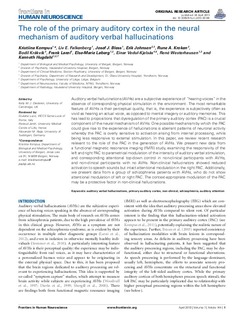| dc.contributor.author | Kompus, Kristiina | |
| dc.contributor.author | Falkenberg, Liv Eggset | |
| dc.contributor.author | Bless, Josef J | |
| dc.contributor.author | Johnsen, Erik | |
| dc.contributor.author | Kroken, Rune | |
| dc.contributor.author | Kråkvik, Bodil | |
| dc.contributor.author | Larøi, Frank | |
| dc.contributor.author | Løberg, Else-Marie | |
| dc.contributor.author | Vedul-Kjelsås, Einar | |
| dc.contributor.author | Westerhausen, René | |
| dc.contributor.author | Hugdahl, Kenneth | |
| dc.date.accessioned | 2015-09-30T08:23:12Z | |
| dc.date.accessioned | 2015-11-11T14:45:32Z | |
| dc.date.available | 2015-09-30T08:23:12Z | |
| dc.date.available | 2015-11-11T14:45:32Z | |
| dc.date.issued | 2013 | |
| dc.identifier.citation | Frontiers in Human Neuroscience 2013, 7:144 | nb_NO |
| dc.identifier.issn | 1662-5161 | |
| dc.identifier.uri | http://hdl.handle.net/11250/2360118 | |
| dc.description.abstract | Auditory verbal hallucinations (AVHs) are a subjective experience of “hearing voices” in the absence of corresponding physical stimulation in the environment. The most remarkable feature of AVHs is their perceptual quality, that is, the experience is subjectively often as vivid as hearing an actual voice, as opposed to mental imagery or auditory memories. This has lead to propositions that dysregulation of the primary auditory cortex (PAC) is a crucial component of the neural mechanism of AVHs. One possible mechanism by which the PAC could give rise to the experience of hallucinations is aberrant patterns of neuronal activity whereby the PAC is overly sensitive to activation arising from internal processing, while being less responsive to external stimulation. In this paper, we review recent research relevant to the role of the PAC in the generation of AVHs. We present new data from a functional magnetic resonance imaging (fMRI) study, examining the responsivity of the left and right PAC to parametrical modulation of the intensity of auditory verbal stimulation, and corresponding attentional top-down control in non-clinical participants with AVHs, and non-clinical participants with no AVHs. Non-clinical hallucinators showed reduced activation to speech sounds but intact attentional modulation in the right PAC. Additionally, we present data from a group of schizophrenia patients with AVHs, who do not show attentional modulation of left or right PAC. The context-appropriate modulation of the PAC may be a protective factor in non-clinical hallucinations. | nb_NO |
| dc.language.iso | eng | nb_NO |
| dc.publisher | Frontiers | nb_NO |
| dc.title | The role of the primary auditory cortex in the neural mechanism of auditory verbal hallucinations | nb_NO |
| dc.type | Journal article | nb_NO |
| dc.type | Peer reviewed | en_GB |
| dc.date.updated | 2015-09-30T08:23:11Z | |
| dc.subject.nsi | VDP::Samfunnsvitenskap: 200::Psykologi: 260::Biologisk psykologi: 261 | nb_NO |
| dc.subject.nsi | VDP::Social sciences: 200::Psychology: 260::Biological psychology: 261 | nb_NO |
| dc.source.volume | 7 | nb_NO |
| dc.source.journal | Frontiers in Human Neuroscience | nb_NO |
| dc.identifier.doi | 10.3389/fnhum.2013.00144 | |
| dc.identifier.cristin | 1109347 | |
| dc.description.localcode | © 2013 Kompus, Falkenberg, Bless, Johnsen, Kroken, Kråkvik, Larøi, Løberg, Vedul-Kjelsås, Westerhausen and Hugdahl. This is an open-access article distributed under the terms of the Creative Commons Attribution License, which permits use, distribution and reproduction in other forums, provided the original authors and source are credited and subject to any copyright notices concerning any third-party graphics etc. | nb_NO |
